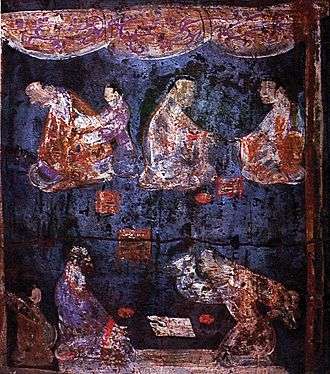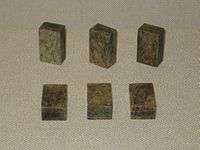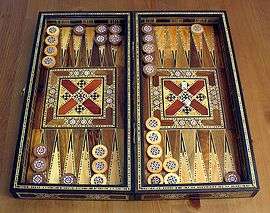Liubo
Liubo (Chinese: 六博; pinyin: liù bó; Wade–Giles: liu po; literally: "six sticks") is an ancient Chinese board game played by two players. For the rules, it is believed that each player had six game pieces that were moved around the points of a square game board that had a distinctive, symmetrical pattern. Moves were determined by the throw of six sticks, which performed the same function as dice in other race games.
The game was invented no later than the middle of the 1st millennium BCE, and was immensely popular during the Han Dynasty (202 BCE – 220 CE). However, after the Han Dynasty it rapidly declined in popularity, possibly due to the rise in popularity of the game of Go, and it eventually became almost totally forgotten. Knowledge of the game has increased in recent years with archeological discoveries of Liubo game boards and game equipment in ancient tombs, as well as discoveries of Han Dynasty picture stones and picture bricks depicting Liubo players.
History
It is not known when the game of Liubo originated, although according to legend it was invented by Wu Cao (烏曹, called Wu Zhou 烏胄 in the early 2nd century CE Shuowen Jiezi dictionary), a minister to King Jie, the last king of the Xia Dynasty, who according to traditional chronology reigned 1728–1675 BCE.[1] Although there is no archeological or reliable documentary evidence to support the view that Liubo dates back to the Shang Dynasty (1600–1046 BCE), early Chinese records do indicate that Liubo was already a popular game by the Warring States period (476–221 BCE). For example, the Records of the Grand Historian records a speech made during the reign of King Xuan of Qi (reigned 319–301 BCE) that claims that the capital city of Linzi was so wealthy that its citizens were all able to indulge in activities such as playing musical instruments, cockfighting, dog racing, playing Liubo and playing kick ball.[2]
The game of Liubo is also described in the mid 3rd century BCE poem "Summons of the Soul" ("Zhao Hun" 招魂) in the Songs of Chu:
Then with bamboo dice and ivory pieces the game of Liu Bo is begun;
Sides are taken; they advance together; keenly they threaten each other.
Pieces are kinged and the scoring doubled. Shouts of ‘five white!’ arise.[3]
The earliest Liubo boards to have been discovered are a pair of ornately decorated stone boards from a 4th-century BCE tomb in the royal tomb complex of the State of Zhongshan at Pingshan in Hebei.[4]
The game reached its greatest popularity during the Han Dynasty, as is evidenced by the discovery of many examples of Liubo boards or sets of Liubo game pieces as grave goods in high status tombs dating to the Han Dynasty. Pottery or wooden figurines of players with model Liubo boards have also been discovered in some Han tombs.[5][6] Engraved picture stones (畫像石) and moulded picture bricks (畫像磚) that were widely used to decorate tombs and temples during the Eastern Han period (25–220 CE) also frequently depict people playing Liubo, sometimes as a small part of a complex scene depicting many different activities, but sometimes as the focal point of the scene, with the players attended by servants and playing in the cool of a pavilion. Some picture stones and engravings on stone coffins, especially those from the area of modern Sichuan and Yunnan provinces, show two winged immortals playing Liubo on a mountain, usually as part of a larger scene depicting the Queen Mother of the West and various mythical animals.
After the end of the Han Dynasty the game seems to have lost its popularity, and there are no known examples of Liubo funerary ware or depictions of Liubo playing later than the Jin Dynasty (265–420). Although the game is still occasionally referred to in some historical sources and in poetry as late as the Tang Dynasty (618–907), it seems that Liubo had been largely displaced by the game of Go. By the time of the Yuan Dynasty (1271–1368) all knowledge of the game of Liubo had been lost, and it is only with the archeological discoveries of recent years that the game has become better known.
There is some evidence that the game of Liubo spread to beyond the confines of China. The Old Book of Tang mentions that Tibetans enjoyed playing both the game of Go and Liubo,[7] but although ancient Tibetan Go boards have been discovered, no examples of Tibetan Liubo boards are known.[8] The Chinese version of the Mahayana Mahaparinirvana Sutra also mentions the playing of several games, including Liubo, which some have taken as evidence that Liubo was transmitted to India. However, to date no examples of Liubo boards have been found outside of China.
Equipment
Liubo boards and game equipment are often found as grave goods in tombs from the Han Dynasty. Various types and sizes of Liubo board have been unearthed, made from a variety of materials, including wood, lacquered wood, pottery, stone and bronze. Some of the boards are simple square slabs of stone or wood, but others are supported by knobs at the four corners, and some are built as tables with long legs. Regardless of their size or shape, the common feature of all Liubo boards is the distinctive pattern that is carved or painted on their surface:

All excavated boards have the angular V-shaped marks at the corners and L-shaped marks at the center of the edges, as well as the central square and T-shaped protrusions, and most boards also have four marks (usually circular but sometimes a decorative pattern) between the corner mark and the central square. However, on some boards each circular mark is replaced by a straight line joining the corner mark to the corner of the inner square, and in a few cases there is no mark between the corner and the square at all.
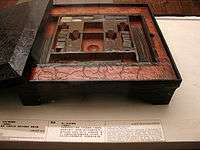
In many tombs only the Liubo board has survived (especially if made of stone or bronze), and it can be assumed that any associated game pieces have decayed, whereas in other cases the game pieces (which are often made of ivory) have survived but the Liubo board (which is often made of wood or lacquer) has rotted away. However, in 1973 a unique, complete set of Liubo equipment in a lacquer box was discovered in a 2nd-century BCE tomb at Mawangdui (believed to be that of the son of the Marquis of Dai). This Liubo set comprises the following items (the Chinese description of the items in the inventory of grave goods that was found in the tomb are given in brackets):[9]
- 1 lacquered wooden game box (45.0 × 45.0 × 17.0 cm.) [博一具]
- 1 lacquered wooden game board (45.0 × 45.0 × 1.2 cm.) [博局一]
- 12 cuboid ivory game pieces (4,2 × 2.2 × 2.3 cm.), six black and six white [象其十二]
- 20 ivory game pieces (2.9 × 1.7 × 1.0 cm.) [象直食其廿]
- 30 rod-shaped ivory counting chips (16.4 cm. long) [象筭三十枚]
- 12 ivory throwing rods (22.7 cm. long) [象□□□□ (last four characters obliterated)]
- 1 ivory knife (22.0 cm. long) [象割刀一]
- 1 ivory scraper (17.2 cm. long) [象削一]
- 1 eighteen-sided die with the numbers "1" through "16" and characters meaning "win" and "lose" [not listed in the inventory]
The six black and six white game pieces are the main game pieces to be moved around the board, and similar sets of cubic or cuboid game pieces made from ivory, jadeite or rock crystal have been found in several other tombs. In at least one case the game pieces are not distinguished by colour, but by having an engraving of a tiger on the pieces of one set and an engraving of a dragon on the pieces of the other set.[10]
The twelve long rods are two sets of the six throwing sticks that the players use to determine their moves, and which the game is named after (Liubo="six sticks"). Most Han stone pictures of Liubo show the players throwing sticks onto a mat between themselves (with the Liubo board to the side of the mat), and ceramic model Liubo sets such as the one excavated in 1972 from Lingbao in Henan province show six sticks lined up neatly between the two players.[11]
Sets of thirty rod-shaped counting chips have also been found in association with Liubo sets from other tombs.[12]
However, the twenty ivory game pieces and the eighteen-sided die in the Mawangdui set are not typically associated with Liubo boards in other tombs, and it is possible that they were not used for playing Liubo, but were equipment for a different game. A similar eighteen-sided die with numbers "1" through "16", "win" and "take a drink" was found in association with two sets of twenty copper, coin-shaped tokens (one set inscribed "Number 1" through "Number 20", and the other set inscribed with three-character lines of poetry) in a Han tomb at Mancheng County in Hebei. No Liubo board or Liubo game pieces were found in the tomb, and because of the inscription "take a drink" (酒來) on one face of the die, the die and sets of tokens are supposed to have been used for a drinking game.[13]
Rules
The exact rules of the game of Liubo are not known, and some of the surviving descriptions of the game are conflicting, which suggests that the game may have been played according to different rules at different times or in different places. The most complete description of the rules of Liubo occurs in a quotation from the lost Book of Ancient Bo (古博經) in a commentary by Zhang Zhan (張湛) to the Book of Liezi that was written during the Jin Dynasty (265–420):
Method of play: Two people sit facing each other over a board, and the board is divided into twelve paths, with two ends, and an area called the "water" in the middle. Twelve game pieces are used, which according to the ancient rules are six white and six black. There are also two "fish" pieces, which are placed in the water. The throwing of the dice is done with a jade. The two players take turns to throw the dice and move their pieces. When a piece has been moved to a certain place it is stood up on end, and called an "owl (梟or驍) ". Thereupon it can enter the water and eat a fish, which is also called "pulling a fish". Every time a player pulls a fish he gets two tokens, and if he pulls two fish in a row he gets three tokens [for the second fish]. If a player has already pulled two fish but does not win it is called double-pulling a pair of fish. When one player wins six tokens the game is won.
Another, somewhat later source, The Family Instructions of Master Yan by Yan Zhitui (531–591) states that there were two variants of Liubo, "Greater Bo" (大博) which was played with six throwing sticks, and "Lesser Bo" (小博) which was played with two dice:[14]
The ancient Greater Bo used six sticks, whereas Lesser Bo used two dice. Nowadays there is no-one who knows how to play, but in those days when it was played it used one die and twelve game pieces. It had very little skill, and was not worth playing.
Most game historians think that Liubo was a race game, and that players moved their six games pieces around the marks on the board. However, others consider Liubo to have been a battle game played with dice or throwing sticks.
There have been several attempts to reconstruct the rules of the game, most notably by Lien-sheng Yang, who discusses the game as it was possibly played on TLV mirrors.[15] Yang theorizes that a player’s piece would start on an L-shaped mark and try to move to a V-shaped corner mark depending on the throw of the sticks. Certain throws would allow a player's piece to move into the center and ‘kill’ the opponent’s piece if it was already there. Once in the center, a piece could begin to block the enemy’s pieces from taking a square. For each block one would gain two points. One could also attempt to recover one’s pieces after they are blocked, and would gain three points for doing this. If one failed to win after having blocked two men, then the opponent would gain six points and win the game. The first player to six points would win the game. Jean-Louis Cazaux has reconstructed similar rules for playing Liubo.[16] An implementation of these reconstructed rules as a playable computer game has also been attempted.[17]
Chupu
A variant of Liubo in which dice were used to make the moves was called Chupu (樗蒲) or Wumu (五木).[18] In Korea the traditional game of jeopo 저포 (hanja: 樗蒲 ) is still played, on a board that is not similar to a Liubo board.[19]
Relationship to other games
There have been attempts to relate Liubo to other board games, and in particular some Chinese scholars believe that Xiangqi (Chinese chess) was based on Liubo.[20] Some Chinese game historians believe that Xiangqi is not related to Western chess, but was based on Liubo, whereas others have suggested that Liubo was transmitted from China to India during the Eastern Jin (317–420), where it developed into Chaturanga, which was the ancestor to both Western chess and Chinese chess.[21] Although many western game historians reject the claim that Xiangqi or other chess variants derive from Liubo,[22] Jean-Louis Cazaux argues that Liubo could have been transformed from a race game to a battle game, and it could then have become Chinese chess.[23]
Liubo patterns on other objects
Liubo mirrors
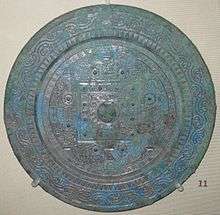
The pattern found on the surface of Liubo boards is also found on the most common type of Han Dynasty bronze mirror, known from their distinctive markings as TLV mirrors. There is some debate over whether the Liubo pattern on these mirrors was simply decorative, or whether it had a ritual significance, or whether perhaps the mirrors doubled as portable Liubo game boards. Zhou Zheng has pointed out that one TLV mirror dating to the reign of Wang Mang (9–23) has an inscription that includes the words "Carved with a Liubo board pattern to dispel misfortune" (刻具博局去[祛]不羊[祥]), which suggests that the main purpose of the Liubo pattern on mirrors was ritual, and that the pattern had a special significance beyond game-playing.[24]
Liubo coins
The Liubo pattern is also sometimes found on the reverse of Wu Zhu coins. Such coins were not used as currency but were probably lucky charms.[25]
Sundials

In 1897 a Han Dynasty stone sundial was discovered in Inner Mongolia which had been overcarved with a Liubo board pattern.[26] The only other complete Han dynasty sundial, in the collection of the Royal Ontario Museum, also has a Liubo pattern carved on it. It may be that the sundials were repurposed as Liubo boards by carving the Liubo pattern over the original sundial markings, or it may be that the Liubo markings were added for some unknown ritual purpose.
Divination boards
In 1993, a wooden board with turtle divination diagrams and prognostications on one side and a Liubo diagram and forty-five prognostications on five topics on the other side was excavated from a late Western Han tomb at Yinwan in Donghai County, Jiangsu.[27] The Liubo diagram is too small to have been used for playing Liubo, and is covered with the sixty terms of the sexagenary cycle which are written all along the lines of the Liubo diagram, in a similar way that the turtle diagram on the other side of the board is filled with the sixty terms. The prognostications under the Liubo diagram are headed with one of nine terms that correspond to the words of an enigmatic, mnemonic rhyme about Liubo written by Xu Bochang (許博昌) during the reign of Emperor Wu of Han (141–87 BCE); Lillian Tseng (Zeng Lanying) argues that these are the names for particular points on the board (the two lines of the "V" mark, the two lines of the "L" mark, the two lines of the "T" mark, the circle or line between the corner and the central square, the outside edge of the central square, and the inside of the central square).[28]

Li Xueqin has suggested that the board was used for divination by matching the day to be divined to the corresponding sexagenary term on the Liubo diagram, and then reading off the corresponding prognostication according to the position of the sexagenary term on the Liubo diagram.[29] However, Lillian Tseng points out that the divination could also be done the other way round, by looking for the desired prognostication (for example an auspicious marriage day), and then all the days on the Liubo board that were written on the position corresponding to the term heading the prognostication would match the desired prognostication.
It has been theorized that the placement of the sixty sexagenary terms on the points of the Liubo divination diagram indicate the possible positions for placing pieces when playing Liubo, and that the sequence of the terms across the divination diagram reflects the path to be followed around the board when playing the game (starting at the north-east corner and ending at the north side of the central square).[30]
Famous Liubo players
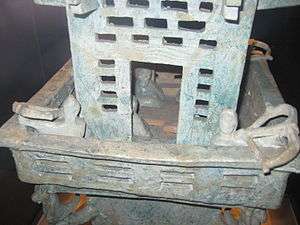
The following is a list of famous people who are recorded to have played Liubo:
- King Mu of Zhou (reigned 977–922 BCE), who according to the apocryphal Travels of King Mu once played a game of Liubo with a hermit that lasted three days.[31]
- Duke Min of Song (宋湣公), who in 682 BCE got into an argument with Nangong Wan 南宮萬 whilst playing Liubo with him, and was killed by Nangong Wan when he hit the duke with the Liubo board.[32]
- King Anxi of Wei 魏安釐王 (reigned 277–243 BCE) and his half-brother Lord Xinling of Wei 信陵君 (died 243 BCE). Once when the two of them were playing Liubo a message came that the beacons on the northern border had been lit; King Anxi wanted to stop the game and discuss the situation with his ministers, but his brother told him not to worry as it was only the king of Zhao on a hunting trip, and so they continued playing. The king was worried and could not concentrate on the game, but after the game was over news came that it was indeed the king of Zhao out hunting.[33]
- Jing Ke (died 227 BCE), the failed assassin of Qin Shi Huang, once had an argument with Lu Goujian (魯句踐) over a game of Liubo, and had to flee for his life.[34]
- Emperor Jing of Han (reigned 156–141 BCE), who when he was crown prince became angry during a game of Liubo with the Prince of Wu, and threw the Liubo board at the prince, killing him (cf. Rebellion of the Seven States).[35]
- Liang Ji (died 159), who according to his biography was fond of playing Liubo.
- Li Guangyan (761–826), a Uyghur general who was presented with a girl who was trained in the arts of "song, dance, music and Liubo".[36]
- Liu Min (895–954), a Shatuo Turk and founder of the Northern Han kingdom, liked to play Liubo and gambling games when he was young.[37]
Confucius famously did not approve of Liubo. In the Analects he grudgingly allows that playing Liubo and Go is better than being idle,[38] and according to the Kongzi Jiayu (Family Sayings of Confucius) he stated that he would not play the game as it promoted bad habits.[39]
See also
References
- ↑ Xu, Shen. 說文解字/06 (Shuowen Jiezi vol. 7) (in Chinese). 維基文庫 (Chinese Wikisource). Retrieved 2009-06-26.
簙:局戲也。六箸十二棊也。从竹博聲。古者烏胄作簙。
- ↑ Sima, Qian. 史記/卷069 [Records of the Grand Historian vol.69] (in Chinese). 維基文庫 (Chinese Wikisource). Retrieved 2009-06-26.
臨菑甚富而實,其民無不吹竽鼓瑟,彈琴擊築,鬥雞走狗,六博蹋鞠者。
- ↑ Hawkes, David (1985). The Songs of the South: An Anthology of Ancient Chinese Poems by Qu Yuan and Other Poets. Harmondsworth: Penguin Books. p. 229. ISBN 0-14-044375-4.
- ↑ Rawson, Jessica (1996). Mysteries of Ancient China. London: British Museum Press. pp. 159–161. ISBN 0-7141-1472-3.
- ↑ 甘肃省博物馆 (Gansu Provincial Museum). 武威磨咀子三座汉墓发掘简报 [Brief report of the excavation of three Han tombs at Mozuizi in Wuwei]. 文物 (Cultural Relics) (in Chinese). 1972 (12): 9–16.
- ↑ 河南省博物馆 (Henan Provincial Museum). 灵宝张湾汉墓 [The Han tomb at Zhangwan in Lingbao]. 文物 (Cultural Relics) (in Chinese). 1975 (11): 80–81.
- ↑ Xu, Liu. 舊唐書/卷196上 [Old Book of Tang vol.196A] (in Chinese). 維基文庫 (Chinese Wikisource). Retrieved 2009-06-26.
圍棋陸博,吹蠡鳴鼓為戲,弓劍不離身。
- ↑ Hazod, Guntram (2002). "The Royal Residence Pho brang byams pa mi 'gyur gling and the Story of Srong btsan sgam po's Birth in Rgya ma". Tibet, past and Present: Tibetan Studies I. Proceedings of the Ninth Seminar of the IATS, 2000. Leiden: Brill. pp. 27–48. ISBN 9004127755.
- ↑ 熊传新 (Xiong Chuanxin). 谈马王堆3号西汉墓出土的陆博 [Discussion of the Liubo set unearthed from the No. 3 Western Han tomb at Mawangdui]. 文物 (Cultural Relics) (in Chinese). 1979 (4): 35–39.
- ↑ 大葆台汉墓发掘组 (Dabaotai Han Tomb Excavation Group) (1989). 北京大葆台汉墓 [The Han tomb at Dabaotai in Beijing] (in Chinese). Beijing: Wenwu chubanshe. p. 53. ISBN 7-5010-0238-X.
- ↑ "The green-glazed liubo-playing pottery figurines". Cultural China. Retrieved 2009-06-26.
- ↑ 莱西县文化馆 (Laixi County Culture Hall). 山東萊西縣岱墅西漢木槨墓 [The Western Han timber-chambered tomb at Daishu in Laixi county in Shandong]. 文物 (Cultural Relics) (in Chinese). 1980 (12): 15.
- ↑ 中国社会科学院考古研究所 (Archeology Research Institute of the Chinese Academy of Social Sciences) (1980). 满城汉墓发掘报告 [Excavation report for the Han tomb at Mancheng] (in Chinese). Beijing: Wenwu chubanshe. pp. 271–274.
- ↑ Yan, Zhitui. 顏氏家訓/卷第7 [The Family Instructions of Master Yan vol. 7] (in Chinese). 維基文庫 (Chinese Wikisource). Retrieved 2009-06-26.
古为大博则六箸,小博则二茕,今无晓者。比世所行,一茕十二棋,数术浅短,不足可翫。
- ↑ Yang, Lien-sheng (June 1952). "An Additional Note on the Ancient Game Liu-po". Harvard Journal of Asiatic Studies. 15 (1): 124–139. doi:10.2307/2718275. JSTOR 2718275.
- ↑ Cazaux, Jean-Louis (2008-01-20). "Reconstructed rules of Liubo". Retrieved 2009-06-26.
- ↑ "The Ancient Game of Liubo". 2011-04-11. Retrieved 2011-04-19.
- ↑ 色子的五木、投瓊和彩戰等
- ↑ "[전통놀이] 저포놀이" [[Traditional Games] Play Jeopo]. 20 May 2011. Retrieved 2011-09-30.
- ↑ "Give up Western Chess – play Chinese Chess instead! (interview between Dr. René Gralla and Prof. David H. Li)". ChessBase. 2005-06-15. Retrieved 2009-06-26.
Professor Li, it seems to be that historians from China endorse your thesis – that the origins of chess can be found in China. In summary: XiangQi originates from the mysterious game Liubo; Liubo turned into GeWu, the latter has turned into Proto-XiangQi. Peter Banaschak analysed the sources that the representatives of the Chinese school cite, and he thinks that all those quotations from the past can be references to some game, but not necessarily to the game of chess or XiangQi.
- ↑ "Liubo – the Ancestor of Board Games". Cultural China. Retrieved 2009-06-26.
According to the research of modern board game historians, liubo is actually the ancestor of all battle board games of the world today, such as Chinese chess, chess etc. These games all evolve from liubo.
- ↑ Banaschak, Peter. "A story well told is not necessarily true – being a critical assessment of David H. Li's "The Genealogy of Chess"". Retrieved 2009-06-26.
- ↑ Cazaux, Jean-Louis (2001). "Is Chess a Hybrid Game ?" (PDF). pp. 5–8. Archived from the original (PDF) on December 16, 2007. Retrieved 2009-06-26.
My idea, very speculative I must confess, is that someone could have turned this race game into a confrontation game opposing in each side the 6 stones as Soldiers, with a notion of promotion during the course of the game, and 10 fishes as Officers. ... Also, to divide the two sides on a battlefield, the best was probably to convert the central water into a river in the middle.
- ↑ 周铮 (Zhou Zheng). "规矩镜"应改称"博局镜" ["Geometric mirrors" should be called "Liubo pattern mirrors"]. 考古 (Archeology) (in Chinese). 1987 (12): 1116–1118.
- ↑ "#54832: China, charm – Wu Zhu coin". Zeno Oriental Coins Database. Retrieved 2009-06-26.
- ↑ 孙机 (Sun Ji). 托克托日晷 [The Togtoh sundial]. 中国历史博物馆馆刊 (Journal of the Museum of Chinese History) (in Chinese). 1971 (3): 74–81.
- ↑ 尹湾汉墓简牍初探 [Preliminary investigation about the wooden slips from the Han tomb at Yinwan]. 文物 (Cultural Relics) (in Chinese). 1996 (10): 68–71.
- ↑ 曾蓝莹 (Lillian Tseng). 尹湾汉墓"博局占"木牍试解 [Attempt to explain the "Liubo divination" wooden slip from the Han tomb at Yinwan]. 文物 (Cultural Relics) (in Chinese). 1994 (8): 62–65.
- ↑ Li Xueqin. "博局占"与规矩纹 ["Liubo board divination" and geometric patterns]. 文物 (Cultural Relics) (in Chinese). 1997 (1): 49–51.
- ↑ Cazaux, Jean-Louis. "Liubo". Retrieved 2009-06-26.
- ↑ 穆天子傳/卷五 [Account of King Mu of Zhou vol.5] (in Chinese). 維基文庫 (Chinese Wikisource). Retrieved 2009-06-26.
是日也,天子北入于邴,与井公博,三日而决。
- ↑ Sima, Qian. 史記/卷038 [Records of the Grand Historian vol.38] (in Chinese). 維基文庫 (Chinese Wikisource). Retrieved 2009-06-26.
十一年秋,湣公與南宮萬獵,因博爭行,湣公怒,辱之,曰:「始吾敬若;今若,魯虜也。」萬有力,病此言,遂以局殺湣公于蒙澤。
- ↑ Sima, Qian. 史記/卷077 [Records of the Grand Historian vol.77] (in Chinese). 維基文庫 (Chinese Wikisource). Retrieved 2009-06-26.
公子與魏王博,而北境傳舉烽,言「趙寇至,且入界」。魏王釋博,欲召大臣謀。公子止王曰:「趙王田獵耳,非為寇也。」複博如故。王恐,心不在博。
- ↑ Sima, Qian. 史記/卷86 [Records of the Grand Historian vol.86] (in Chinese). 維基文庫 (Chinese Wikisource). Retrieved 2009-06-26.
荊軻遊於邯鄲,魯句踐與荊軻博,爭道,魯句踐怒而叱之,荊軻嘿而逃去,遂不復會。
- ↑ Sima, Qian. 史記/卷106 [Records of the Grand Historian vol.106] (in Chinese). 維基文庫 (Chinese Wikisource). Retrieved 2009-06-26.
孝文時,吳太子入見,得侍皇太子飲博。吳太子師傅皆楚人,輕悍,又素驕,博,爭道,不恭,皇太子引博局提吳太子,殺之。
- ↑ Xu, Liu. 列传第一百一十一 [Biographies chapter 111]. 旧唐书 (Old Book of Tang) (in Chinese). 梦远书城 (my285.com). Retrieved 2009-06-26.
- ↑ Xue, Juzheng. 舊五代史/卷135 [Old History of the FIve Dynasties vol. 135] (in Chinese). 維基文庫 (Chinese Wikisource). Retrieved 2009-06-26.
- ↑ Kong, Qiu. 論語/陽貨第十七 [Analects ch. 17] (in Chinese). 維基文庫 (Chinese Wikisource). Retrieved 2009-06-26.
子曰:「飽食終日,無所用心,難矣哉!不有博弈者乎?為之,猶賢乎已!」
- ↑ 孔子家語/卷一 [Family Sayings of Confucius vol. 1] (in Chinese). 維基文庫 (Chinese Wikisource). Retrieved 2009-06-26.
哀公問於孔子曰:“吾聞君子不博,有之乎?”孔子曰:“有之。”公曰:“何為?”對曰:“為其二乘。”公曰:“有二乘,則何為不博?”子曰:“為其兼行惡道也。”
External links
| Wikimedia Commons has media related to Liubo. |
- Liubo Illustrated article by Jean-Louis Cazaux
- Pictures of Liubo artefacts on the Cultural China website
- Andrew West, Pictures of funerary statuettes of Liubo Players
